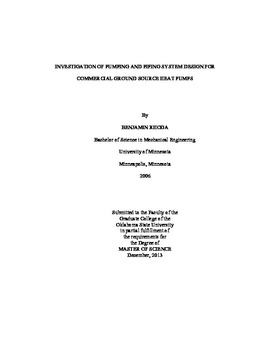| dc.contributor.advisor | Spitler, Jeffrey D. | |
| dc.contributor.author | Rhoda, Benjamin | |
| dc.date.accessioned | 2015-06-17T20:07:40Z | |
| dc.date.available | 2015-06-17T20:07:40Z | |
| dc.date.issued | 2013-12-01 | |
| dc.identifier.uri | https://hdl.handle.net/11244/19480 | |
| dc.description.abstract | This study focused on the simulation of previously researched design methodologies and pumping strategies and compared them in detailed simulations to see the impacts of certain designs on the performance of the pumping energy and the performance of the heat pumps. This included both direct and reverse return systems, pipe sizing criteria, central and distributed pumping, and a combined central with distributed pumping, the effects of differential temperature set point, and differential pressure set point. This study also compared the traditional two-pipe distribution system to the one-pipe distribution system. Through the analysis, the most important factor in pumping performance was the control mechanisms used and pump efficiency. The variance in energy consumption between the four configurations that were studied was at most 7%. Using 0.61 m (2 ft) of head loss per 30.5 m (100 ft) of pipe as a pipe sizing technique was the transition point for the pumping power to go from a `B' to an `A' grade. Ensuring the pump is equipped to be shut off when no heat pumps are operating can save significant amounts of energy. The one-pipe system had the lowest pumping energy of all four configurations but also had the highest heat pump energy consumption. As a result, the one-pipe system consumed the most energy for all four locations that were analyzed. The best performing system in all four locations was the two-pipe configuration with distributed-pumping-with-hydraulic-separation assuming a circulator pumping efficiency of 50% as is attainable with ECM pumps. The temperature differential set point to control the ground loop fluid flow rate varied depending on the location. If a standard induction motor pump is used, the two-pipe system with central pumping was the best performing configuration. | |
| dc.format | application/pdf | |
| dc.language | en_US | |
| dc.publisher | Oklahoma State University | |
| dc.rights | Copyright is held by the author who has granted the Oklahoma State University Library the non-exclusive right to share this material in its institutional repository. Contact Digital Library Services at lib-dls@okstate.edu or 405-744-9161 for the permission policy on the use, reproduction or distribution of this material. | |
| dc.title | Investigation of Pumping and Piping System Design for Commercial Ground Source Heat Pumps | |
| dc.type | text | |
| dc.contributor.committeeMember | Fisher, Daniel | |
| dc.contributor.committeeMember | Cremaschi, Lorenzo | |
| osu.filename | Rhoda_okstate_0664M_13069.pdf | |
| osu.accesstype | Open Access | |
| dc.description.department | Mechanical Engineering | |
| dc.type.genre | Thesis | |
| dc.subject.keywords | ground source heat pump | |
| dc.subject.keywords | pumping | |
